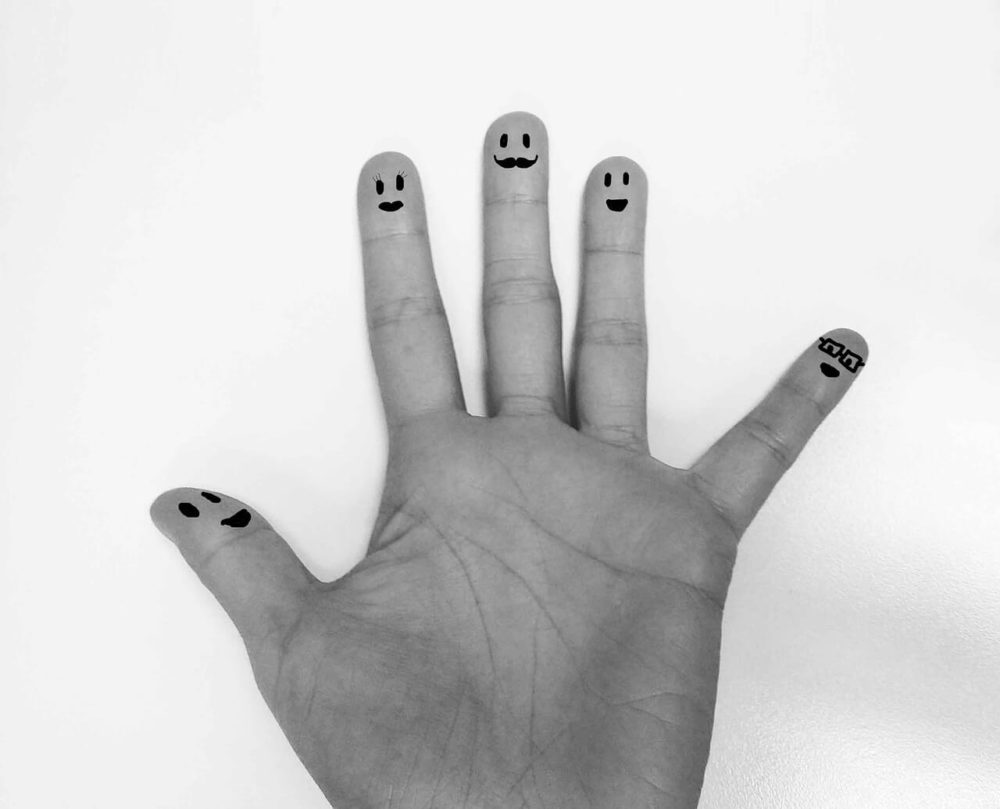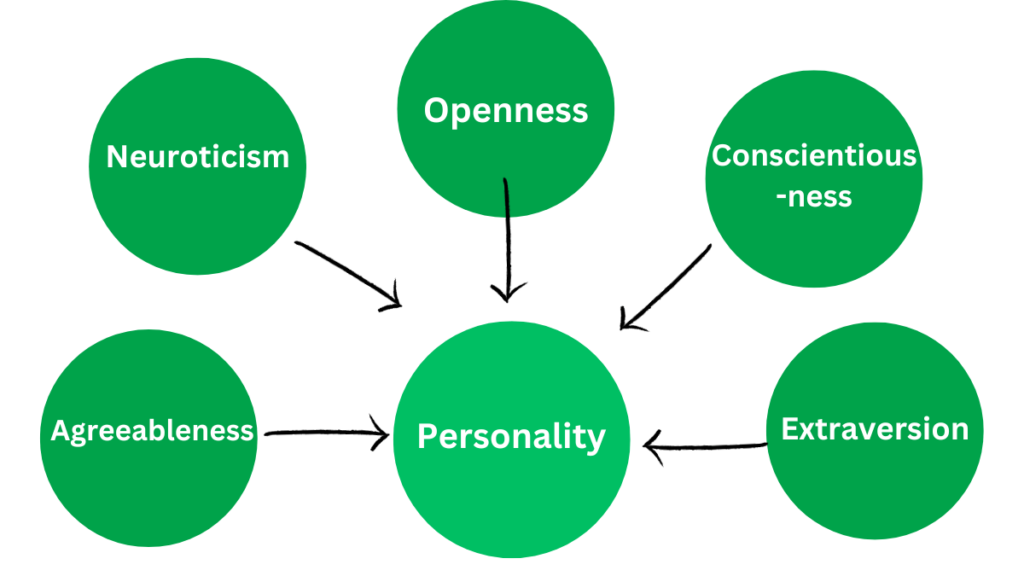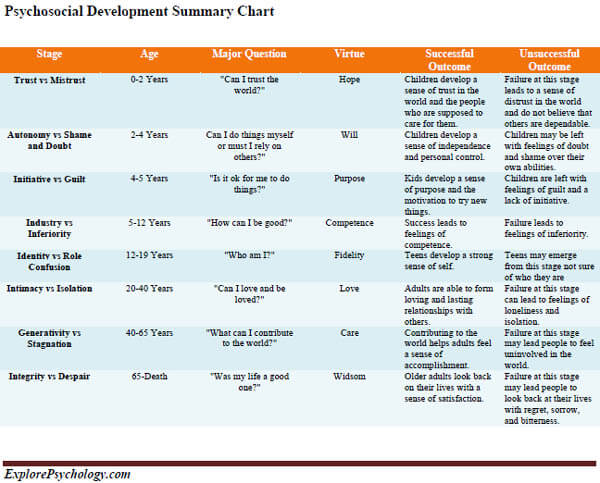Big Five Personality Traits: Here’s What You Need to Know
While there have been many different theories of personality, many psychologists today believe that personality is made of five broad dimensions, a notion often referred to as the big five theory of personality or the five-factor model. The Big 5 personality traits the theory describes are: The Big Five Personality Traits We mentioned these big…

While there have been many different theories of personality, many psychologists today believe that personality is made of five broad dimensions, a notion often referred to as the big five theory of personality or the five-factor model. The Big 5 personality traits the theory describes are:
- Openness
- Conscientiousness
- Extroversion
- Agreeableness
- Neuroticism

The Big Five Personality Traits
We mentioned these big five traits earlier, but let’s look at them in greater depth. One important thing to remember is that each dimension represents a continuum. Some people may be at one extreme or another on a particular dimension, with most lying somewhere in the middle.
Does this suggest that personality is made up of only five traits? Not at all. Remember, each of the five factors represents a broad spectrum of traits. Extroversion, for example, encompasses such qualities as talkativeness, outgoingness, assertiveness, and friendliness.
The Big 5 traits represent broad dimensions of personality. Each dimension is a continuum that includes those who are high, low, and in between.
The body of evidence supporting the Big Five theory has grown in recent decades, although it has also been the subject of critique.
Let’s take a closer look at each of the dimensions described by the Big Five theory:
Openness
This Big Five personality trait is also referred to as openness to experience and describes a spectrum between being curious and cautious.
High Openness Traits
People who rate high in openness tend to be creative, inventive, and adventurous.
They tend to have a great deal of intellectual curiosity, prefer to avoid routine, and seek out novel experiences. This can sometimes take the form of thrill-seeking and participating in high-risk activities such as sky diving, bungee jumping, and gambling.
Other characteristics of openness include:
- Open-minded
- Abstract thinker
- Unpredictable
- Unfocused
Low Openness Traits
Those who rate low in openness tend to be careful and consistent. They appreciate routines and are often wary or even resistant to change.
They may base decisions on carefully considered data, avoid taking excessive risks and can sometimes be close-minded when encountering information that challenges existing beliefs.
Other characteristics of low levels of openness include:
- Enjoying structure
- Being dogmatic
- Resisting new ideas
- Avoiding risk
Conscientiousness
The conscientiousness big five personality trait describes a continuum between being highly efficient and very careless.
High Conscientiousness Traits
People who are high in conscientiousness are efficient and thoughtful.
Some characteristics of those who are high in this trait include:
- High achieving
- Perfectionistic
- Ambitious
- Dutiful
- Organized
- Dependable
- Self-Disciplined
- Stubborn
Low Conscientiousness Traits
Those who are low in this trait tend to be easy-going but often thoughtless. While they are often seen as relaxed, they can sometimes be perceived as sloppy or even lazy.
Some more characteristics of people low in conscientiousness include:
- Spontaneous
- Irresponsible
- Undependable
- Tardy
- Messy
Extroversion
Extroversion, sometimes spelled extraversion, describes a continuum between being outgoing and reserved. Extroverts typically gain energy from social interactions – socializing with other people helps them feel recharged and inspired.
High Extroversion Traits
Some of the common characteristics of people high in extroversion include being:
- Talkative
- Gregarious
- Assertive
- Sociable
- Domineering
- Attention-seeking
Low Extroversion Traits
Those who are low in extroversion are known as introverts. They have to expend energy in social settings, so spending lots of time with others can feel draining. Because of this, they often need periods of solitude to recharge.
Other characteristics include:
- Quiet
- Reticent
- Solitary
- Reserved
- Reflective
- Aloof
Agreeableness
The big five personality trait of agreeableness refers to the tendency to be cooperative and helpful rather than antagonistic and disagreeable. It encompasses qualities such as trust, prosocial behaviors, and kindness.
High Agreeableness Traits
Agreeable people tend to be friendly, likable, and good-natured. Being very high in agreeableness is sometimes seen as gullible, naive, or overly trusting.
Some more characteristics of those who are high in agreeableness include:
- Even-tempered
- Cooperative
- Compassionate
- Empathetic
- Generous
Low Agreeableness Traits
People who are low in agreeableness tend to be distrustful and detached. Other characteristics of low agreeableness include:
- Antagonistic
- Untrustworthy
- Uncooperative
- Ill-tempered
- Argumentative
Neuroticism
Neuroticism centers on emotional stability.
High Neuroticism Traits
People who are high in this trait are more likely to experience unpleasant emotions such as sadness, anger, and anxiety.
More characteristics of being high in neuroticism include:
- Sensitivity
- Nervousness
- Moodiness
- Unstable
- Insecure
- Excitable
Low Neuroticism Traits
Those who are low in this dimension, on the other hand, tend to be calm and even-tempered. Other characteristics associated with being low on the neuroticism dimensions include:
- Confidence
- Security
- Stable
- Dull
- Uninspired
Other Trait Theories
There are many different theories of personality. Trait theories attempt to describe personality as composed of a number of different traits which then influence how people behave.
Just how many traits are there? Theorists have proposed a variety of numbers to capture all of the traits that make up the human experience:
- An early psychologist named Gordon Allport, the man often credited with helping to popularize psychology in America, examined dictionary terms related to personality traits and concluded that there were more than 4,000.
- Later, the psychologist Raymond Cattell utilized a statistical technique known as factor analysis to whittle that list down to just 16.
- Hans Eysenck shortened that list to a mere three broad dimensions, but later researchers revised and expanded this to include five dimensions of personality.
Rather than focusing on individual terms that describe every aspect of a trait, the Big Five theory aims to instead focus on the broader aspects of human personality.
History of the Big 5 Personality Traits
It is important to remember that each dimension represents a spectrum. Each high and low pole represents the extremes of each trait, but people typically lie somewhere between the two sides.
The big five personality traits were derived from analyzing surveys of thousands of people to determine which traits tend to occur together. Using factor analysis, researchers were able to group related traits together under broad dimensions.
The five domains identified by the big five theory are thought to encompass all know personality traits.
As you might have already realized, exceptions are possible. A person who ranks high in introversion might be quiet but not necessarily reticent. A person who is highly extroverted might be sociable but not necessarily assertive.
The Big Five personality traits describe only a portion of what personality psychologists study. Other aspects of personality such as motivations, attitudes, self-concepts, and emotions also play a role in making you who you are, but the Big Five theory does not touch upon such subjects.
What Causes of the Big Five Personality Traits?
So what factors influence the development of the Big Five personality traits? As with many questions in psychology, both nature and nurture play a role.
In one large-scale twin study, researchers found that the heritability of the openness dimensions was the highest, with 61% being attributed to genetic influences. Conscientiousness was 44% due to genetics, with extroversion, agreeableness, and neuroticism being at 53%, 41%, and 41%, respectively.
Age is another factor that can influence the five core dimensions. As people age and mature, some of these traits tend to change.
For example, people typically become less extroverted as they grow older. It is also common to become less open and neurotic while also becoming more agreeable and conscientious.
Are the Big 5 Personality Traits Universal?
The Big Five personality traits, also known as the Five Factor Model (FFM), have been extensively researched and have gained widespread acceptance in the field of psychology. These traits are considered relatively universal. They offer a comprehensive framework for describing and understanding human personality across different cultures and societies.
Research has consistently shown that these traits can be identified and measured in various cultures and are relatively stable over time. That doesn’t mean there aren’t cultural variations in the expression and emphasis of these traits. However, the core dimensions themselves appear to transcend cultural boundaries.
For instance, traits like conscientiousness, which relates to organization and dependability, are universally valued in work and social contexts, although the specific behaviors associated with this trait may differ from culture to culture.
Similarly, extraversion and introversion may manifest differently in social behaviors and norms, but the underlying personality dimension remains relevant and applicable worldwide.
The takeaway is that the Big Five traits provide a valuable and cross-culturally valid framework for understanding human personality, highlighting the universal aspects of our individual differences while recognizing the influence of culture on their expression.
Using the Big Five Theory to Understand Your Own Personality
The Big Five theory isn’t just a tool that researchers use to assess personality traits. It can also be a tool for learning more about yourself, gaining deeper self-awareness, and achieving personal growth.
Take a Big 5 Personality Test
Start by taking a reliable Big Five personality assessment. There are many free and paid tests available online. These tests will provide you with scores on each of the five traits.
Reflect on Your Scores
Once you have your scores, reflect on what they mean. Consider the descriptions and characteristics associated with each trait.
For example, if you scored high in conscientiousness, you might be organized, goal-oriented, and detail-oriented. If you scored low in neuroticism, you are likely to be emotionally stable and resilient.
Identify Strengths and Weaknesses
Use your scores to identify your strengths and weaknesses. For example, if you score low in extraversion but high in agreeableness, you might excel in roles that require empathy and cooperation, such as a counselor or mediator.
Set Personal Goals
Use your understanding of your personality traits to set personal and professional goals. If you know you’re low in conscientiousness, you might work on developing better organizational skills to enhance your efficiency.
Improve Communication and Relationships
Understanding your personality traits can also help you communicate more effectively with others. If you know you’re highly openness to experience, you might be more accepting of different viewpoints, which can improve your relationships.
Adapt and Grow
Recognize that your personality is not fixed. While it’s influenced by genetics and upbringing, you can work on developing traits that are important to your personal and professional success.
For instance, if you score low in extraversion but want to become more socially adept, you can gradually practice social interactions.
Related reading:
Sources:
Cobb-Clark, DA & Schurer, S. The stability of big-five personality traits. Economics Letters. 2012; 115(2): 11–15.
Gerlach M, Farb B, Revelle W, Nunes Amaral LA. A robust data-driven approach identifies four personality types across four large data sets. Nat Hum Behav. 2018;2(10):735-742. doi:10.1038/s41562-018-0419-z
Jang, K.L. et al. (1996). Heritability of the big five personality dimensions and their facets: A twin study. Journal of Personality, 64(3); 577-591.
Power RA, Pluess M. Heritability estimates of the Big Five personality traits based on common genetic variants. Translation Psychiatry. 2015;5:e604. doi:10.1038/tp.2015.96





